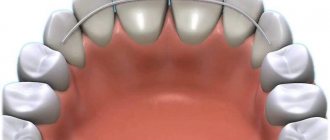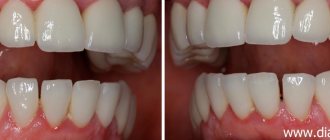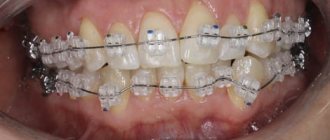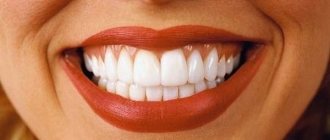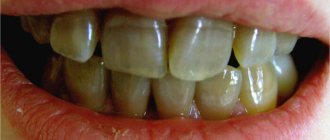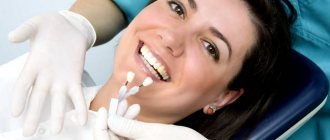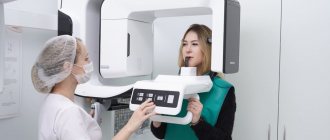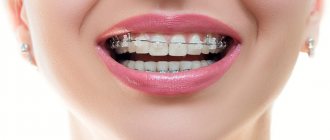Braces are an orthodontic design that allows you to correct malocclusion and straighten your teeth. After completing the full course of treatment with a braces system, the patient ceases to experience discomfort associated with malocclusion: biting his cheeks and lips, experiencing the joy of calmly biting food and easily closing the upper and lower jaws. However, when using braces there is some peculiarity - a possible change in facial features. Next, we’ll tell you why and how braces change your face.
The severity of transformation depends on the following aspects:
- - degree of deformation of the dentition;
- - type of pathological bite;
- — to what extent the patient complies with the orthodontist’s recommendations.
After wearing braces, the shape of your face may change. But how noticeable this will be directly depends on the personal characteristics of the patient’s jaw and the degree of malocclusion.
Content:
- Who is recommended for teeth straightening with braces?
- Preparing to align rows with braces
- Installation of braces
- Wearing braces during teeth straightening
- Removing the leveling device
- How long to wear braces
- When alignment with braces is not possible
How do braces straighten teeth? They do not do this by themselves, since in reality they play only a secondary role. After all, the term “braces” hides tiny locks that are responsible for holding the metal arch. It is the latter that does all the leveling work - moves the curved units and forces them to take the correct positions. But it just so happened that the entire orthodontic structure was named after the miniature locks.
When teeth don't move according to plan
In some cases, during dental correction, mobility increases abnormally due to the development of osteomyelitis, osteoporosis or exacerbation of periodontal diseases (gingivitis, periodontitis and periodontal disease).
No one is immune from the development of diseases of the skeletal system. But problems with gums can result from insufficient care of braces and the oral cavity or unprofessional diagnosis at the preparatory stage. Before installing an orthodontic device, gingivitis must be treated, and periodontal disease and periodontitis must be transferred to a stage of stable remission.
In any case, the attending physician will do everything possible to eliminate the problem and minimize its consequences.
Who is recommended for teeth straightening with braces?
The process of correcting malocclusion is long and complex. A couple of months cannot significantly affect bone tissue; you need to wear an orthodontic device for a year or more. Day after day, the arch will exert the required force on the dentition, as a result of which units that are out of place or at the wrong angle will begin to correct themselves.
Indications for wearing braces are:
- incorrectly formed bite;
- anomalies in the location of individual canines, incisors or molars;
- preparation for prosthetics;
- improving the aesthetics of a smile in the presence of dentofacial curvatures.
The doctor makes the decision to conduct orthodontic therapy after an in-person examination and preliminary diagnostics. It is important for the patient to listen to the dentist’s instructions. Then he will have a chance to make his smile beautiful and healthy in the coming years.
Stages of treatment with braces
Correcting a bite with braces takes place in several stages:
- Preparation for orthodontic treatment - obtaining x-rays, OPTG, TRG and others. The doctor will also refer you for treatment of caries and pulpitis if he diagnoses signs of dental problems. Additionally, professional teeth cleaning and, in rare cases, removal of individual teeth are indicated.
- Fixation of the bracket system. The doctor will attach the plates under the arch on the patient’s teeth and install a wire of a suitable diameter and shape. During the treatment process, the orthodontist will gradually increase the diameter of the arches, and at the final stage, use a rigid rectangular wire.
- Removal of braces and retention period. The last stage is necessary to secure the position of the teeth in the correct positions. To do this, the patient is given a non-removable retainer on the sublingual side or night guards are prescribed.
The duration of treatment with braces depends on many factors - the complexity of the pathology being corrected, the anatomical characteristics of the patient, and the selected brace material.
Preparing to align rows with braces
Before installing braces, the doctor makes sure that the gums and teeth are in satisfactory condition.
If there is caries, pulpitis, gingivitis or any other dental disease, it must be treated. After installing metal arches, it is much more difficult to combat the symptoms of oral diseases. Also during the preparatory stage:
- radiography;
- taking impressions of both jaws;
- articulator examination.
Considering that each clinical case is unique, the patient may be prescribed consultations with a surgeon, orthopedist, or implantologist.
How can I help the process?
While the tissues are weakened and the teeth are loose, it is necessary to prevent excessive stress on them.
- You should not chew whole hard carrots and hard apples, or bite caramels, nuts and seeds.
- Avoid viscous and sticky foods - dried fruits, toffees and chewing gum.
- Don't bite your nails, pens or pencils. In this way, you will not only protect weakened teeth, but also maintain the integrity of the braces system.
- Preference should be given to porridges, vegetable purees, and meat pates.
In order for bone regeneration to occur normally and the teeth to not become too loose by the time the orthodontic structure is removed, you need to include in your diet foods containing proteins, as well as all the necessary minerals and vitamins.
Installation of braces
When the patient's oral cavity is prepared for orthopedic therapy, he is invited to an appointment. Most often, retaining clasps are fixed in a direct way, that is, they are glued separately to each unit. But with the advent of modern dental technologies, doctors can also use an indirect fixation method - through mouth guards.
The standard procedure takes about one and a half hours and is carried out according to the following scheme:
- removing tartar using an ultrasonic scaler;
- washing and drying crowns;
- application of primer and adhesive;
- alternate gluing of locks;
- removing excess adhesive from the surface of dental crowns;
- light polymerization.
When gluing locks, it is important to leave just enough adhesive on the enamel as needed. If there is too much of it, it will come out from under the metal bases and will become colored with food coloring over time. Then the space surrounding the castles will become gray and spoil your smile.
If you remove too much of the cured compound, large gaps will form between the braces and the enamel. Food will begin to accumulate in them, and pathogenic microorganisms will begin to multiply. And this is a direct path to caries and related complications.
Consequences of distal occlusion
Any violation of facial proportions removes a person’s appearance from the ideal of beauty and reduces his attractiveness. Insufficient development of the lower third of the face, an inexpressive chin, protruding teeth - all this creates an unfavorable impression of a person. In addition to this, other problems develop over time:
- diction suffers;
- the process of chewing food becomes difficult, which negatively affects the functioning of the entire digestive system;
- improper distribution of chewing load reduces the service life of teeth, leads to rapid abrasion of enamel, tooth loss due to inflammatory processes in the periodontium;
- pathological changes in the temporomandibular joints lead to the appearance of clicking sounds when chewing and become one of the causes of frequent headaches;
- If a patient has malocclusion, prosthetics becomes difficult, and the service life of crowns and dentures decreases.
Problems increase gradually, and their presence is not always associated with existing prognathia. However, it is better to think about your health when correction of the distal bite can be carried out as planned.
Wearing braces during teeth straightening
After installing braces, the patient must come for consultations at intervals specified by the doctor. During them, the doctor will analyze the changes and change the degree of pressure of the arc on the dentition. At first the mechanism puts little pressure on the rows, but gradually it becomes more and more rigid. This is necessary for the teeth to finally take the correct positions.
When using a brace device, the patient should adhere to the following rules:
- Do not create temperature changes in the oral cavity, do not eat too hot or very cold foods. This also applies to drinks. If you ignore this recommendation, the locks may peel off from the enamel. Also, deformation of the metal arc cannot be ruled out, which is unacceptable, since it will “drag” curved units with it.
- Forget about chewing gum. It happens that they stick to the elements of the system, then cleaning them is very problematic.
- Do not eat crackers or seeds. They are stuffed under the parts of the orthodontic structure. It's difficult to get them out. If you do not pay attention to their accumulation, the risk of caries will increase.
- Do not chew hard foods (nuts, crackers, hard vegetables), as the apparatus may break while chewing them. It is unlikely to be repaired, which means that you will have to start the alignment procedure from the very beginning.
- Maintain good oral hygiene. Pay special attention to the condition of the enamel and gums. When cleaning hard-to-reach places, use not only a brush, but also floss and irrigator. After each meal you should rinse your mouth with warm water.
If any questions arise while straightening teeth with braces, the patient should immediately contact an orthodontist. The doctor will advise and give practical recommendations.
Loosen to move
When installing a turnkey bracket system , the orthodontist first of all takes care of making the teeth mobile under the traction of the orthodontic arch, after which they can be forced to move along the calculated trajectory. And if they started to stagger, it means everything is going according to plan. How is it possible to first move them from their usual position, and finally re-fix them in the jaw bone?
Teeth with braces become loose due to the coordinated work of cells such as osteoblasts and osteoclasts. The dental crown and root are connected by a ligament, which, in turn, is supported by bone tissue. When the tooth begins to tilt under the influence of traction, the distance between the crown and the ligament increases on one side and decreases on the other. Osteoblasts begin to make up for the lack of bone tissue in order to support the tooth in a new place, and osteoclasts begin to remove the “excess” and dissolve it. In this case, the compressed connective ligament straightens out over time, and the tooth has the full right to take the new position planned by the orthodontist.
The cycles of resorption and growth during orthodontic treatment are repeated many times, causing a kind of “rejuvenation” and strengthening of bone tissue and, of course, correcting the dentition. But since it takes a lot of time to increase tissue density, and resorption occurs faster, the teeth remain mobile for a long time.
Removing the leveling device
When day “x” arrives, the patient can’t wait to see his new beautiful smile.
But you won’t be able to enjoy her appearance for long. The fact is that after removing the braces you will have to wear retainers for some time. These are thin wires that prevent a healthy bite from becoming abnormal again.
Afterwards, you may need to use a mouth guard. Only when the risk of the curvature returning disappears will the doctor allow you to permanently abandon all corrective mechanisms.
What to do after removing braces
Removing braces requires cleaning the surface of the crown from the remaining adhesive mixture onto which the system's locks were attached. The doctor uses a bur to remove residues and polishes the surface with a special attachment. In this case, not only the smoothness of the crown is restored, but the tone is also evened out, stains that can appear when smoking, eating curry dishes, or red wine are eliminated. The color of the teeth lightens.
The final removal of the adhesive mixture and polishing takes from 15 to 30 minutes. The average length of a visit to the orthodontist's office to remove braces is about 60 minutes. In some cases, a specialist carries out procedures for remineralization, protection, and removal of tartar.
How long to wear braces
Straightening teeth is a very painstaking process. Regardless of the type and material of the leveling structure, it will have to be worn for 1-1.5 years. In some cases, the duration of treatment is 2 years. If we take into account the need for subsequent use of retainers and mouth guards, the time period will increase even more.
No need to be upset. The jaws quickly get used to the metal arches, and therefore after just a few weeks of using them, a person practically stops noticing them. It is much wiser to spend one or two years on orthodontic therapy than to suffer for the rest of your life due to an incorrect bite.
Reasons for the formation of pathology
The development of dentofacial curvature is based on a hereditary predisposition, which is “layered” with damaging environmental factors. It also matters what affects the child during the period of intrauterine development, and the conditions under which the formation of the dental system occurs in the first years of life. The following three factors have the greatest influence.
Features of artificial feeding
When using special orthodontic nipples or when breastfeeding, the newborn has to make efforts to get milk. The tension of the facial muscles necessary for this stimulates the correct and uniform development of the jaws. When feeding from a bottle with a regular nipple, the baby practically does not strain. Because of this, the dental-jaw system lags significantly behind in development, which becomes the “background” for the development of various anomalies.
Nasal breathing disorder
The habit of breathing through the mouth leads to elongation and excessive increase in the size of the upper jaw, while the lower jaw lags behind it in proportions. According to statistics, diseases of the ENT organs are observed in every third child with a distal bite.
Violation of the process of changing teeth
Here, the cause of the development of prognathia may be the untimely loss of baby teeth due to injury or caries, improper eruption of permanent teeth, underdevelopment or lack of formation of permanent teeth. Unfortunately, many adults underestimate the importance of timely correction of primary and secondary dentition. As a result, where it was possible to get by with a temporary prosthesis, expensive braces have to be installed.
Children who do not have fangs on the lower jaw are at risk of developing prognathia. They have a malfunction of the articulatory apparatus, and the growth of the lower jaw slows down. Implantation can help in this situation.
Predisposing factors for the development of dentofacial pathology include cases of poor posture, rickets, the habit of thumb sucking, and the use of an irregularly shaped pacifier.
When alignment with braces is not possible
You cannot straighten your teeth using braces if:
- Full or partial edentia. There will simply be nothing to consolidate the basics on.
- Acute mental disorders. A mentally ill person may want to remove the device themselves and cause harm to themselves.
- Diabetes mellitus, severe diseases of the immune and endocrine systems. With these pathologies, the condition of blood vessels and bone tissue worsens. If the tissue becomes inflamed after braces are installed, the tooth may become loose and fall out.
It is also not recommended to install braces if you have bleeding disorders, HIV infection, sexually transmitted diseases, tuberculosis, or oncology. Treatment of malocclusions using braces requires a responsible and competent approach. Therefore, it is very important to entrust the therapy to an experienced and highly qualified doctor.
What is a distal bite?
A synonymous name for this type of dentoalveolar curvature is “prognathia.” Its peculiarity is an imbalance in the development of the jaws, in which the lower jaw lags behind the upper jaw. At the same time, the teeth of the upper jaw protrude above the lower ones, and the chin is underdeveloped and seems small in comparison with other parts of the face. The general facial expression changes. A person with prognathia appears surprised or unhappy.
The often used term “deep distal bite” seems to us not entirely correct, since deep occlusion is an independent disorder that can develop in a patient as a result of his existing prognathism.
The severity of the distal bite can be determined by the closure of the sixth upper tooth with its “neighbor” located in the lower dentition. In the severe stage, the first large molar of the upper jaw comes into contact simultaneously with the large and small molars of the lower jaw. If the tooth comes into contact mainly with its antagonist, then the degree of violation is regarded as mild.
Feelings after removing braces
Most patients note that it is not painful to remove braces and the surface of the teeth is not damaged after removing locks, rings and other structural elements. Discomfort can only be caused by unsticking locks and polishing. This is explained:
- individual characteristics of the teeth structure;
- changes in pH and microflora of the oral cavity while wearing the structure;
- violation of the trophism of dental tissues under braces;
- demineralization processes.
Increased tooth sensitivity can cause pain after removal of the structure. To eliminate anomalies, the doctor, after professional cleaning and polishing of the teeth, carries out measures to restore the enamel - applies special remineralizing mixtures, coats the crowns with protective varnish.
The pain is explained by the physiology of the dental system. After treatment, teeth tend to take their usual position, so their location is stabilized with retainers. But most patients experience a feeling of relief and liberation after removing the device. If the patient carefully follows the recommendations and takes care of his teeth and gums throughout the course of treatment, then after removing the corrective system he will not experience any unpleasant consequences.
